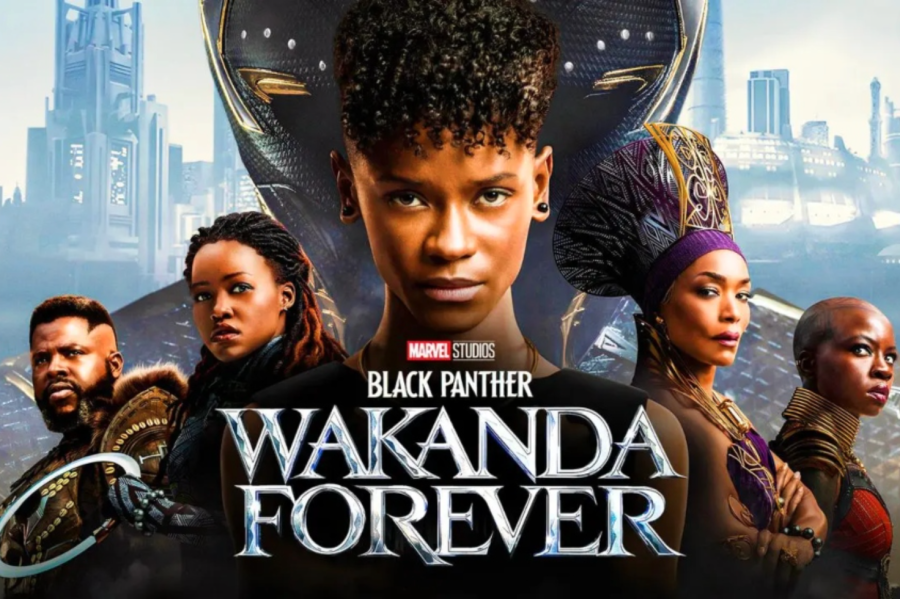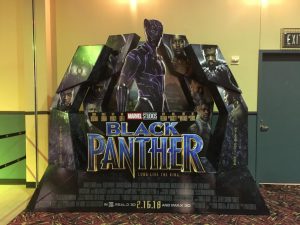Wakanda Forever: high expectations and racial representations
After the passing of Black Panther’s lead actor, Chadwick Boseman, fans wondered about the future of the franchise. With the sequel hitting the cinemas Friday, senior staff reporter, Andrew Jauregui takes a look at the representation the movie brings for people of color.
November 14, 2022
The latest film in the Marvel Cinematic Universe, Black Panther: Wakanda Forever, opened just a few days ago. The film has had the attention of many, since the passing of Chadwick Boseman, the film had to be rewritten and reformed into a sequel that could live up to the financial and critical success of Black Panther.
The character of King T’Challa, the Black Panther, was as important to our world as he was to the fictional one he belonged to. He was a symbol of empowerment and representation to those of African descent. With Boseman gone, those who looked to him, like junior Kevin Crawford, entered theaters this weekend unsure if the film would treat the Black Panther’s death with the respect it deserved.
“Going into the movie, I expected a lot,” Crawford said. “Since Chadwick passed away I wondered how they would handle his passing, and they did perfectly. They made sure that they walked through it and everybody was good and realized that this is Chadwick’s passing. The grieving period was really good.”
Although the film treated the absence of Boseman with the respect it deserved, that wouldn’t be the only challenge the film had to face. With such a monumental place in our media culture, replacing T’Challa with a character or characters that could live up to what he represented would not be simple.
In this sequel, the main character is Shuri, the sister of T’Challa portrayed by Letita Wright, who takes up her brother’s mantle as Black Panther. Boseman’s Black Panther had been especially relatable to black males, so his succession by his sister had to be handled with care.
“In the first Black Panther, Chadwick Boseman was a strong, black, male role model I could look up to in my own acting,” Crawford said. “When a movie is good, then it doesn’t matter if the character is male or female. This is one of those movies. This is a movie about struggle. It didn’t matter if the Black Panther was male or female because the struggle is still real, and you understand the story.”
Beyond Shuri taking on the role of Black Panther, the film furthered the character development of key female figures like Queen Ramonda, mother of T’Challa and Shuri, and her royal guard, the Dora Milaje. For junior Kadence Phearse, the development is welcome.
“I loved that they were initially warriors in the first one,” Phearse said. “But I liked how it switched up in this one. I feel like a lot of women have more power, and I like seeing them on screen together and spending more time in the first one. I also liked how they showed Shuri and her mom’s relationship together and how they interacted. You really don’t see the women together as much unless they’re all in a group.”
Black Panther became a high point for its portrayal of black faces and stories, and while this film continues to do the same, it also incorporates Mayan culture in its depiction of Namor. One of Marvel’s oldest characters, debuting in 1939, Namor the Submariner has been a long-awaited addition to the MCU. In the film, we are shown a group of indigenous Mayans who turned to a magical plant in order to save themselves from disease brought over by conquistadors. The plant turned those Mayans into creatures that could breathe underwater.
Born among these creatures would be Namor, played by Tenoch Huerta. Under the leadership of Namor, they create the city of Talokan, the MCU’s version of Atlantis, a city heavily inspired by Mayan architecture and culture. For Mexican-American Studies teacher Yuridiana Franco, Namor and Mayan culture are an important addition to mainstream media.
“My parents are from Mexico, we have an indigenous heritage. I’m 43% indigenous so that’s a big connection for me,” she said. “I think that is the most important part. His character is also that he looks like me and my family. It’s huge because there are very few examples of Mayan history in Hollywood. I can think of just one other movie, Apocalypto, which does not represent the people in the kindest way. Black Panther was a beautiful way to respect the culture of the Mayan people and show them under a more positive light. It is meaningful whenever you see your culture or background represented in such a wonderful way.”








